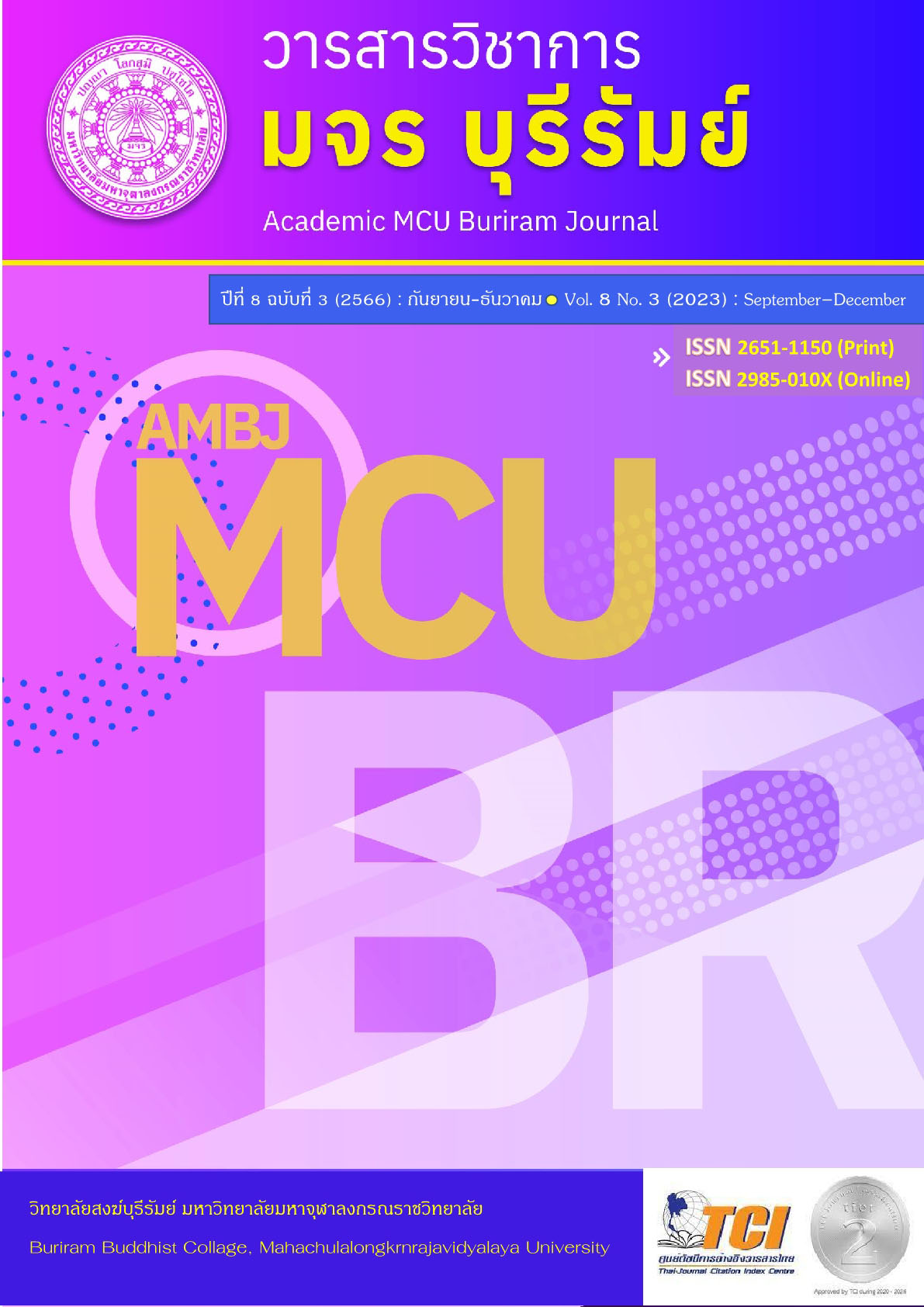การมีส่วนร่วมของประชาชนในการป้องกันการแพร่ระบาด Covid -19 ตามหลักสัมมัปปธาน 4 ในเขตอำเภอสนม จังหวัดสุรินทร์
คำสำคัญ:
การมีส่วนร่วมของประชาชน, การป้องกันการแพร่ระบาด Covid-19, หลักสัมมัปปธาน 4บทคัดย่อ
การวิจัยนี้ มีวัตถุประสงค์เพื่อ 1) ศึกษาระดับการมีส่วนร่วมของประชาชนในการป้องกันการแพร่ระบาด covid 19 ตามหลักสัมมัปปธาน 4 ในเขตอำเภอสนม จังหวัดสุรินทร์ 2) เปรียบเทียบความคิดเห็นการมีส่วนร่วมของประชาชนในการป้องกันการแพร่ระบาดcovid-19 ตามหลักสัมมัปปธาน 4 จำแนกตาม เพศ อายุ ระดับการศึกษาและอาชีพ 3) ศึกษาข้อเสนอแนะการมีส่วนร่วมของประชาชนในการป้องกันการแพร่ระบาด covid-19 ตามหลักสัมมัปปธาน 4 กลุ่มตัวอย่าง ได้แก่ ประชาชนที่มีอายุตั้งแต่ 18 ปีขึ้นไป จำนวน 380 คน เป็นงานวิจัยเชิงปริมาณ เครื่องมือที่ใช้ในการเก็บรวบรวมข้อมูลเป็นแบบสอบถามมาตราส่วนประมาณค่า 5 ระดับ มีความเที่ยงตรงเชิงเนื้อหา เท่ากับ 0.67-1.00 และมีความเชื่อมั่นเท่ากับ .98 สถิติที่ใช้ในการวิเคราะห์ข้อมูลได้แก่ ความถี่ ร้อยละ ค่าเฉลี่ย และส่วนเบี่ยงเบนมาตรฐาน และสถิติที่ใช้ในการทดสอบสมมุติฐานได้แก่ ค่า t-test และ F-test (One-Way ANOVA)
ผลการวิจัยพบว่า
1. การมีส่วนร่วมของประชาชนในการป้องกันการแพร่ระบาด covid -19 ตามหลักสัมมัปปธาน 4 โดยรวมอยู่ในระดับมาก (=3.62) โดย ด้านที่มีค่าเฉลี่ยสูงสุด คือ การมีส่วนร่วมในการดำเนินกิจกรรม (
=3.67) รองลงมา คือ การมีส่วนร่วมในการรับประโยชน์ (
=3.62) ส่วนด้านที่มีค่าเฉลี่ยต่ำสุด คือ การมีส่วนร่วมในการตัดสินใจ (
=3.58)
2. ผลการเปรียบเทียบระดับการมีส่วนร่วมของประชาชนในการป้องกันการแพร่ระบาด covid 19 ตามหลักสัมมัปปธาน 4 จำแนกตามเพศและระดับการศึกษา ไม่แตกต่างกัน ส่วนจำแนกตามอายุ แตกต่างกันอย่างมีนัยสำคัญทางสถิติที่ระดับ .05
3. ข้อเสนอแนะการมีส่วนร่วมของประชาชนในการป้องกันการแพร่ระบาด covid 19 ตามหลักสัมมัปปธาน 4 พบว่า ควรเปิดโอกาสให้ประชาชนมีส่วนร่วมในโครงการรณรงค์ป้องกันโรคโควิค-19 โดยให้เข้ามาร่วมวางแผน ปฏิบัติและประเมินงาน เพื่อแก้ปัญหาของชุมชนที่จะทำให้เกิดประโยชน์สูงสุดต่อชุมชน
เอกสารอ้างอิง
กรมควบคุมโรค กระทรวงสาธารณสุข. (2564). แนวทางการให้วัคซีนโควิด 19 ในสถานการณ์การระบาดปี 64 ของประเทศไทย ปรับปรุงครั้งที่ 2. นนทบุรี: กรมควบคุมโรคติดต่อ.
กองสนับสนุนสุขภาพภาคประชาชน กรมสนับสนุนบริการสุขภาพ. (2563). คู่มือ อสม. ยุคใหม่. กรุงเทพฯ: ชุมนุมสหกรณ์การเกษตรแห่งประเทศไทย.
กระทรวงสาธารณสุข. (2563). คู่มือการป้องกันและควบคุมโรคติดเชื้อไวรัสโคโรนา 2019 สำหรับประชาชน. กรุงเทพฯ: โรงพิมพ์ชุมนุมสหกรณ์.
บุญชม ศรีสะอาด. (2545). การวิจัยเบื้องต้น. พิมพ์ครั้งที่ 7. กรุงเทพฯ: สุวีริยาสาส์น.
พระพรหมคุณาภรณ์ (ป.อ.ปยุตฺโต). (2552). พุทธธรรม ฉบับปรับปรุงและขยายความ. พิมพ์ครั้งที่ 11. กรุงเทพฯ: โรงพิมพ์มหาจุฬาลงกรณราชวิทยาลัย.
เมตต์ เมตต์การุณ์จิต. (2553). การบริหารจัดการศึกษาแบบมีส่วนร่วม: ประชาชน องค์กรปกครอง ส่วนท้องถิ่น และราชการ. พิมพ์ครั้งที่ 2. กรุงเทพฯ: บุ๊คพอยท์.
ฆายนีย์ ช.บุญพันธ์. (2565). พฤติกรรมการมีส่วนร่วมของประชาชนในการป้องกัน การแพร่ระบาดของเชื้อไวรัสโคโรนา 2019 (โควิด-19): กรณีศึกษาตำบลยะหา อำเภอยะหา จังหวัดยะลา. วิทยานิพนธ์ปริญญามหาบัณฑิต. มหาวิทยาลัยสงขลานครินทร์.
ธนพัชญ์ เผือกพิพัฒน์. (2564.) การมีส่วนร่วมในการปฏิบัติตามมาตรการของรัฐ ในสถานการณ์โควิด-19 กรณีศึกษา : แขวงคลองจั่น เขตบางกะปิ กรุงเทพมหานคร. วารสารการบริหารการปกครองและนวัตกรรมท้องถิ่น, 5(2), 1-14.
รัถยานภิศ รัชตะวรรณ และคณะ. (2561). กระบวนการมีส่วนร่วมของชุมชนในการพัฒนาสุขภาวะ. วารสารเทคโนโลยีภาคใต้, 11(1), 231-238.
วรยุทธ นาคอ้าย, กมลนัทธ์ม่วงยิ้ม และเดชา วรรณพาหุล. (2563). กระบวนการมีส่วนร่วม ในการป้องกันโรคโควิด 19 กรณีศึกษา ผู้สูงอายุพฤฒิพลังชุมชนหนองตะโก. วารสารมนุษยศาสตร์และสังคมศาสตร์มหาวิทยาลัย ธนบุรี, 14(3), 20–30.
สถาบันวิจัยระบบสาธารณสุข. (2563). โครงการวิเคราะห์รายจ่ายต่อหัวที่ปรับด้วยโครงสร้างอายุของระบบหลักประกันสุขภาพ. กรุงเทพฯ: สำนักงานหลักประกัน สุขภาพแห่งชาติ.
สอยฤทัย เกลี้ยงนิล. (2563). รัฐ-ชุมชนกับการจัดการภัยพิบัติโรคไวรัส COVID-19 ถนนข้าวสาร เขตพระนคร กรุงเทพมหานคร. เข้าถึงได้จาก http://www3.ru.ac.th/mpa-abstract/files/2562_1597741815_6114832006.pdf (สืบค้นเมื่อ 20 มีนาคม 2564).
สุมาลี จุทอง. (2563). การจัดการภัยพิบัติโรคระบาด COVID-19 ในพื้นที่ชุมชนหมากน้อย. เข้าถึงได้จาก http://www3.ru.ac.th/mpa-abstract/files/2562_ 1597737114_6114832048.pdf (สืบค้นเมื่อ 20 มีนาคม 2564).
Gilmore, B., Ndejjo, R., Tchetchia, A., de Claro, V., Mago, E., Diallo, A. A., Bhattacharyya,S. (2020). Community engagement for COVID-19 prevention andcontrol: A rapidevidencesynthesis. BMJ Global Health, 5(10), 59-70. e003188. doi:10.1136/bmjgh-2020-003188
Krejcie, R. V., & Morgan, D. W. (1970). Determining sample size for research activities. Educational and Psychological Measurement, 30(3), 607-610.
Sathiadas, M. G. (2020). Community participation during Covid-19. Jaffna Medical Journal, 32(1), 1-12. 1.doi:10.4038/jmj.v32i1.84
ดาวน์โหลด
เผยแพร่แล้ว
รูปแบบการอ้างอิง
ฉบับ
ประเภทบทความ
สัญญาอนุญาต
ลิขสิทธิ์ (c) 2023 วารสารวิชาการ มจร บุรีรัมย์

อนุญาตภายใต้เงื่อนไข Creative Commons Attribution-NonCommercial-NoDerivatives 4.0 International License.
ทัศนะและความคิดเห็นที่ปรากฏในบทความวารสารฉบับนี้ถือเป็นความรับผิดชอบของผู้เขียนบทความนั้น ไม่ถือเป็นทัศนะและความรับผิดชอบของบรรณาธิการ





